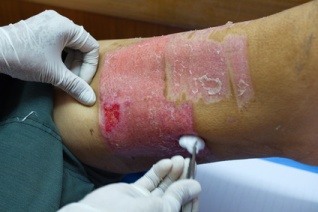Skin Graft Donor Sites
A skin graft is a section of epidermis and dermis harvested from one part of the body and reaffixed to a site where the skin has been removed or damaged. Unlike flaps, which are connected to a blood supply, skin grafts lack a blood supply of their own, and must rely on the recipient wound bed for nutrients.
When contemplating a skin graft in wound reconstruction, the donor site must also be considered. It is often more painful than the recipient wound due to exposed dermal nerve endings.

Treatment of Skin Graft Donor Sites
For full-thickness skin grafts, the donor site wound heals by primary intention (sutured together). However, for split-thickness skin grafts, the wound heals by reepithelialization. Epithelial cells migrate from the remnants of the underlying dermis across the wound bed. Donor site wounds take on average 7-10 days to heal and typically progress through two distinct phases of healing. The first is the wet phase, where the wound is highly exudative and best managed with an absorbent dressing.
The second phase is the dry phase, where exudate levels fall off and the wound bed becomes dry. During this phase, a non-adherent dressing should be used that can be left in place, so as to not disturb the fragile wound bed. Consider medicating the patient prior to dressing change to minimize discomfort.
References
Beldon P. What you need to know about skin grafts and donor site wounds. Wound Essentials. 2007;2:149-155. http://www.woundsinternational.com/pdf/content_196.pdf. Accessed May 24, 2018.
Havill S. Skin grafting. DermNet NZ. http://dermnetnz.org/procedures/graft.html. Accessed May 24, 2018.
Hubbard M. Managing Skin Grafts and Donor Sites. Ostomy Wound Management. http://www.o-wm.com/content/managing-skin-grafts-and-donor-sites. Published February 1, 2010. Accessed May 24, 2018.







